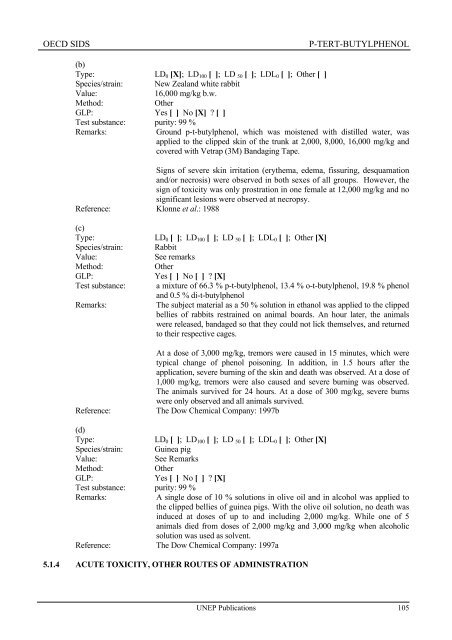p-Tert-Butylphenol - UNEP Chemicals
p-Tert-Butylphenol - UNEP Chemicals
p-Tert-Butylphenol - UNEP Chemicals
Create successful ePaper yourself
Turn your PDF publications into a flip-book with our unique Google optimized e-Paper software.
OECD SIDS P-TERT-BUTYLPHENOL<br />
(b)<br />
Type: LD0 [X]; LD100 [ ]; LD 50 [ ]; LDL0 [ ]; Other [ ]<br />
Species/strain: New Zealand white rabbit<br />
Value: 16,000 mg/kg b.w.<br />
Method: Other<br />
GLP: Yes [ ] No [X] ? [ ]<br />
Test substance: purity: 99 %<br />
Remarks: Ground p-t-butylphenol, which was moistened with distilled water, was<br />
applied to the clipped skin of the trunk at 2,000, 8,000, 16,000 mg/kg and<br />
covered with Vetrap (3M) Bandaging Tape.<br />
Signs of severe skin irritation (erythema, edema, fissuring, desquamation<br />
and/or necrosis) were observed in both sexes of all groups. However, the<br />
sign of toxicity was only prostration in one female at 12,000 mg/kg and no<br />
significant lesions were observed at necropsy.<br />
Reference: Klonne et al.: 1988<br />
(c)<br />
Type: LD0 [ ]; LD100 [ ]; LD 50 [ ]; LDL0 [ ]; Other [X]<br />
Species/strain: Rabbit<br />
Value: See remarks<br />
Method: Other<br />
GLP: Yes [ ] No [ ] ? [X]<br />
Test substance: a mixture of 66.3 % p-t-butylphenol, 13.4 % o-t-butylphenol, 19.8 % phenol<br />
and 0.5 % di-t-butylphenol<br />
Remarks: The subject material as a 50 % solution in ethanol was applied to the clipped<br />
bellies of rabbits restrained on animal boards. An hour later, the animals<br />
were released, bandaged so that they could not lick themselves, and returned<br />
to their respective cages.<br />
At a dose of 3,000 mg/kg, tremors were caused in 15 minutes, which were<br />
typical change of phenol poisoning. In addition, in 1.5 hours after the<br />
application, severe burning of the skin and death was observed. At a dose of<br />
1,000 mg/kg, tremors were also caused and severe burning was observed.<br />
The animals survived for 24 hours. At a dose of 300 mg/kg, severe burns<br />
were only observed and all animals survived.<br />
Reference: The Dow Chemical Company: 1997b<br />
(d)<br />
Type: LD0 [ ]; LD100 [ ]; LD 50 [ ]; LDL0 [ ]; Other [X]<br />
Species/strain: Guinea pig<br />
Value: See Remarks<br />
Method: Other<br />
GLP: Yes [ ] No [ ] ? [X]<br />
Test substance: purity: 99 %<br />
Remarks: A single dose of 10 % solutions in olive oil and in alcohol was applied to<br />
the clipped bellies of guinea pigs. With the olive oil solution, no death was<br />
induced at doses of up to and including 2,000 mg/kg. While one of 5<br />
animals died from doses of 2,000 mg/kg and 3,000 mg/kg when alcoholic<br />
solution was used as solvent.<br />
Reference: The Dow Chemical Company: 1997a<br />
5.1.4 ACUTE TOXICITY, OTHER ROUTES OF ADMINISTRATION<br />
<strong>UNEP</strong> Publications 105
















